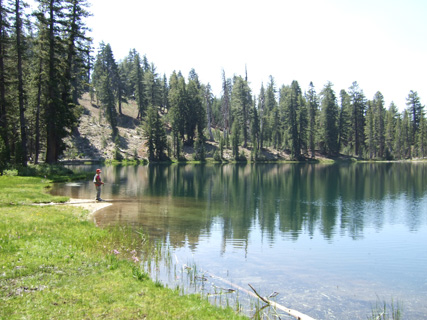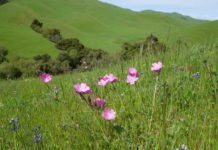It is possible to walk to Eden
Our caravan trooped up a steady incline through mixed groves of
red and Douglas fir trees.
One weekday morning a couple weeks ago, we packed a ridiculous
amount of food and water that would miraculously disappear within
hours. We were six
– eight including the dogs – and we were bound for a place I’d
last visited 25 years ago.
It is possible to walk to Eden
Our caravan trooped up a steady incline through mixed groves of red and Douglas fir trees.
One weekday morning a couple weeks ago, we packed a ridiculous amount of food and water that would miraculously disappear within hours. We were six – eight including the dogs – and we were bound for a place I’d last visited 25 years ago.
Nellie Lake is set at about 9,000 feet in the central Sierra, within the shadow of Kaiser Peak. The walk began at 7,000 feet near the west end of Huntington Lake. The agenda called for a 10-mile amble with 2,300 feet of elevation gain.
The hike was the most ambitious ever undertaken by one member of the group, nephew Josh. Josh is an athletic middle schooler determined to rid the Sierra Nevada entirely of its population of trout. He was accompanied by Charlie, a dog that, given his druthers, would never leave Josh’s side.
Also along were a daughter, two nieces, sister-in-law, Sparky the wonder dog and me.
The walk led us past pocket meadows and walls of silvery Sierra granite. Wildflowers – skyrockets, columbine, asters, shooting stars, paintbrush – exploded around us.
We gained enough elevation that we began to look and listen for Clark’s nutcrackers, gray and black relatives of jays and crows. The birds bear the name of William Clark, who also got second billing as a leader of the Lewis and Clark expedition. The two were not shy about hanging their names on many Western species they encountered. Elegant clarkia and Lewis’ woodpecker come to mind first.
Soon we heard one of the raucous birds and it made a flyby. I always think of them as the town criers of the true high country. They cache enormous numbers of pine nuts each year to survive the winters, since it remains in its mountainous home year-round. The birds’ well-stocked pantries allow them to begin breeding in January or February.
Looking for marmots, nutcrackers or an uncommon wildflower helped distract us from the fact that we were panting a little as we approached 9,000 feet. Sparky ran ahead and back, eager to turn a 10-mile walk into a 20-miler and oblivious to his own panting.
We dropped over a rocky ridge and below us was Nellie, one of the prettiest Sierra Lakes I’ve ever seen.
The lake was a thick minestrone of life. Damsel and dragonflies skipped over its surface. Reeds at the water’s edge were perches for thousands of the glittering insects. A few patches of snow lingered, but the lake was warm enough for a refreshing, not numbing, dip.
There was another reason for the dip. The lake hosted clouds of voracious mosquitoes. After bathing in insecticides, we sat on a point, hoping to catch enough breeze to hold them at bay. Lunch was delicious and soon, we started back.
One of the younger members of the party observed that it seemed funny to walk for so long only to spend a little while in such a beautiful spot. Then another observed that it’s not about the destination as much as it is the journey.
Our party came to a trail junction, and it was decided Sparky and the women in the group would return to our base via Mary’s Meadow. They came back exclaiming about the wild garden they had traversed. Some of us spent a good portion of the evening poring over wildflower books, hoping (unsuccessfully) to sort out the riot of form and color seen that day. All day long we encountered only one other party of hikers.
Josh, Charlie and I returned the way we had come. It was one of the rare days when Josh would return home fishless, but he was concerned that more hiking might be too much for his little dog. I explained that, given the life already filling Nellie Lake, his offering of a travel-weary night crawler was not likely to excite fishy appetites.
That night, we gathered outside, craning our necks back to see a sky so filled with stars that it was hard to sort out individual constellations. Every minute or so, a satellite would track across the starscape.
The younger members of the group agreed it had been one of the best mountain days ever.
I could only smile. My parents were good enough to put us into the wilderness when they could and it stuck with us. Seeing another generation come to love the place, to love breathing hard as they carry themselves into the high country did, indeed, prove that it was one of the best mountain days ever.









